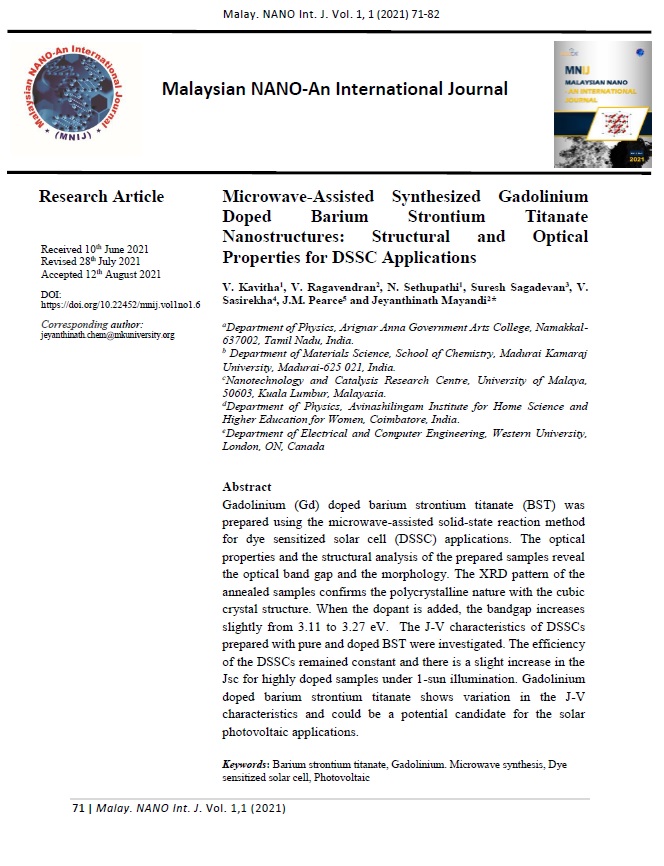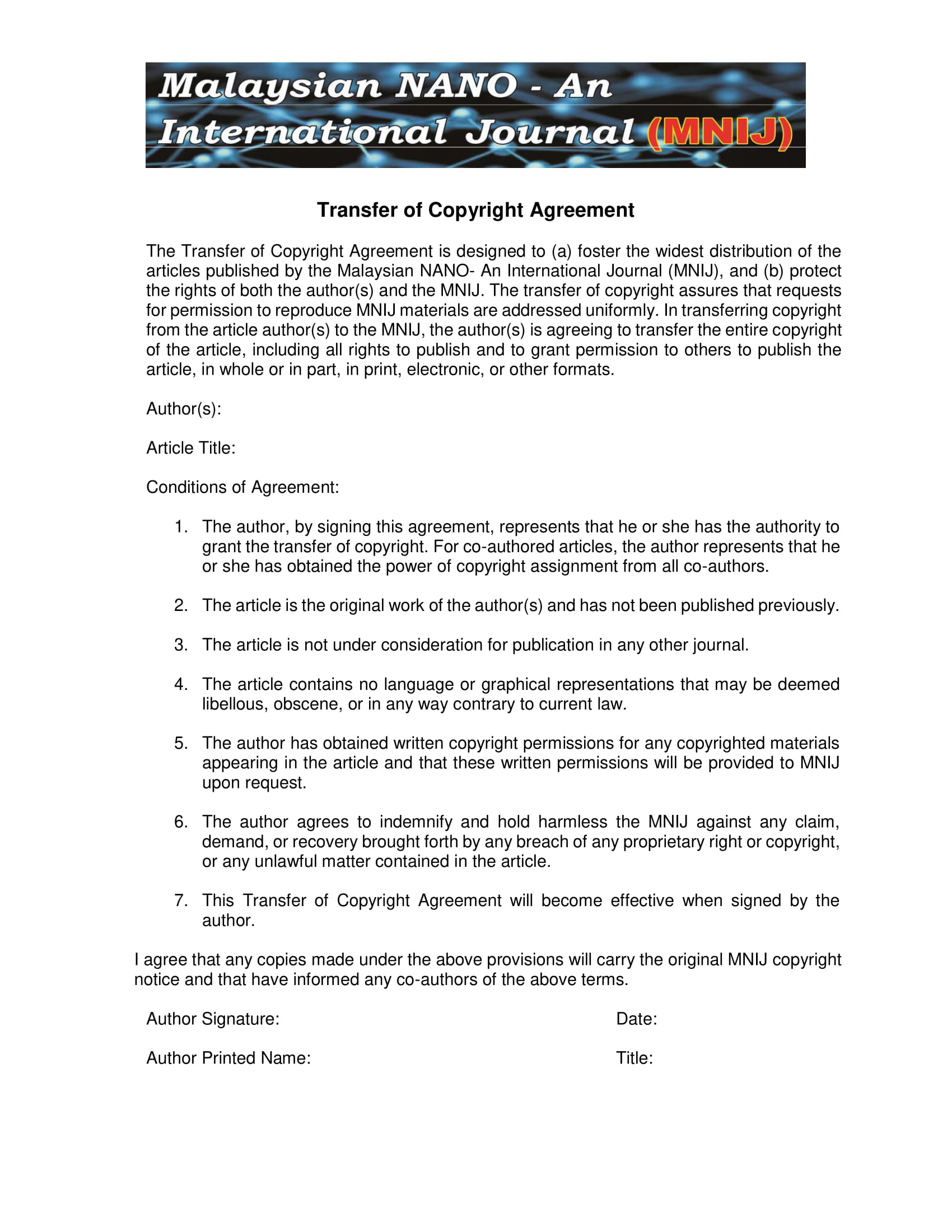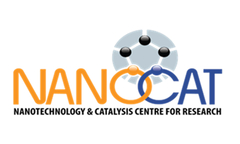Microwave-Assisted Synthesized Gadolinium Doped Barium Strontium Titanate Nanostructures: Structural and Optical Properties for DSSC Applications
DOI:
https://doi.org/10.22452/mnij.vol1no1.6Keywords:
Barium strontium titanate, Gadolinium, Microwave synthesis, Dye sensitized solar cell, PhotovoltaicAbstract
Gadolinium (Gd) doped barium strontium titanate (BST) was prepared using the microwave-assisted solid-state reaction method for dye sensitized solar cell (DSSC) applications. The optical properties and the structural analysis of the prepared samples reveal the optical band gap and the morphology. The XRD pattern of the annealed samples confirms the polycrystalline nature with the cubic crystal structure. When the dopant is added, the bandgap increases slightly from 3.11 to 3.27 eV. The J-V characteristics of DSSCs prepared with pure and doped BST were investigated. The efficiency of the DSSCs remained constant and there is a slight increase in the Jsc for highly doped samples under 1-sun illumination. Gadolinium doped barium strontium titanate shows variation in the J-V characteristics and could be a potential candidate for the solar photovoltaic applications.
Downloads
References
K. Branker, M.J.M. Pathak, J.M. Pearce. "A review of solar photovoltaic levelized cost of electricity." Renewable and sustainable energy reviews. 2011; 15, 9: 4470-4482.
F. Robert. Service, Giant batteries and cheap solar power are shoving fossil fuels off the grid sciencemag.org, news. 2019; 11, (07)
N.M. Haegel, Jr.H. Atwater, T. Barnes, C. Breyer, A. Burrell, Yet-M.Chiang, S. De Wolf, Terawatt-scale photovoltaics: Transform global energy, Science. 2019; 364, 6443: 836-838,
Singh, Rajendra. Why silicon is and will remain the dominant photovoltaic material. Journal of Nanophotonics. 2009; 3: 032503.
Metz, A., M. Fischer, and J. Trube. International technology roadmap for photovoltaics (ITRPV): Crystalline silicon technology-current status and outlook. Proceedings of the PV Manufacturing in Europe Conference, Brussels, Belgium. 2017
Oberbeck, Lars, Katherine Alvino, Baljeet Goraya, and Marie Jubault. IPVF's PV technology vision for 2030. Progress in Photovoltaics: Research and Applications. 2020; 28, no. 11: 1207-1214.
Srivastava, Sanjay K., Prashant Singh, Avritti Srivastava, P. Prathap, Sushil Kumar, C. M. S. Rauthan, and D. K. Aswal. Nanostructured Black Silicon for Efficient Thin Silicon Solar Cells: Potential and Challenges. In Recent Advances in Thin Films. Springer, Singapore. 2020; 549-623.
Modanese, Chiara, Hannu S. Laine, Toni P. Pasanen, Hele Savin, and Joshua M. Pearce. Economic advantages of dry-etched black silicon in passivated emitter rear cell (PERC) photovoltaic manufacturing. Energies 11. 2018; no. 9: 2337.
Andreani, Lucio Claudio, Angelo Bozzola, Piotr Kowalczewski, Marco Liscidini, and Lisa Redorici. Silicon solar cells: toward the efficiency limits. Advances in Physics. 2019; X 4, no. 1: 1548305.
T. Unold, H.W. Schock. "Nonconventional (non-silicon-based) photovoltaic materials." Annual Review of Materials Research. 2011; 41: 297-321.
D. Nikolić, B. Milorad, S. Jasmina, R. Jasna, T. Dragan. A review of non-silicon and new photovoltaics technology for electricity generation. Proceedings of the International Conference on Renewable Energy Sources – MKOIEE. 2018; 2,1: 1-7.
R. Jose, T. Velmurugan, R. Seeram, Metal oxides for dye sensitized solar cells. J. Am. Ceram. Soc. 2009; 92, 2: 289-301.
J.Mayandi, S. Mahalakshmi, V. Ragavendran Optical and structural studies of BaTiO3 and SrTiO3. Journal of Nano Science and Nano Technology. 2014; 2: 735-738.
Thomas, Sara, T. G. Deepak, G. S. Anjusree, T. A. Arun, Shantikumar V. Nair, and A. Sreekumaran Nair. A review on counter electrode materials in dye-sensitized solar cells. Journal of Materials Chemistry. 2014; A2, no. 13: 4474-4490.
Pai, Yun-Yi, Anthony Tylan-Tyler, Patrick Irvin, and Jeremy Levy. Physics of SrTiO3-based heterostructures and nanostructures: a review. Reports on Progress in Physics. 2018; 81, no. 3: 036503.
P. Jayabal, V. Sasirekha, J. Mayandi, K. Jeganathan, V. Ramakrishnan, “A facile hydrothermal synthesis of SrTiO3 for dye sensitized solar cell application”. Journal of Alloys and Compounds. 2014; 586: 456–461
J. Vinodhini, J. Mayandi, R. Atchudan, P. Jayabal, V. Sasirekha, Effect of microwave power irradiation on TiO2 nano-structures and binder free paste screen printed dye sensitized solar cells. Ceramics International, Elsevier. 2019; 45, 4: 4667-4673.
Y Shen, BST-inspired Smart Flexible Electronics. Electronic Theses and Dissertations. 2012; 2483.
R. Pazik, D. Hreniak, W. Strek, A. Speghini, M. Bettinelli, Structural and luminescence properties of Eu3+ doped BaxSr1-xTiO3 (BST) nanocrystalline powders prepared by different methods. Optical Materials. 2006; 28: 1284–1288.
A.W. Nuayi, A. Husin, S.H. Irzaman and R. Mamat,, Enhancement of Photon Absorption on BaxSr1−xTiO3 Thin-Film Semiconductor Using Photonic Crystal. International Journal of Optics. 2014; 534145: 1- 8,
Z. Xu, H. Qiang Enhanced electrocaloric effect in Mn + Y co-doped BST ceramics near room temperature, Materials Letters. 2017; 191: 57-60
Reenu J, Harikrishnan G N, Jayakumari I. Processing and Applications of Ceramics. 2015; 9: 73-79
Z Chen, C Fangxu, L Zhixin, J Gang and L Yuanliang. Microstructure and dielectric properties of La2O3 doped Ti-rich barium strontium titanate ceramics for capacitor applications. Materials Science-Poland. 2017; 35: 806-815.
A. Setiawan, Aminullah, J. Juansah, Irzaman, Optical and Electrical Characterizations of Niobium-doped Ba0.25Sr0.75TiO3 (BSNT) on p-type Silicon and Corning Glass Substrates and its Implementation as Photodiode on Satellite of LAPAN – IPB”. Procedia Environmental Sciences. 2016; 33: 620-625.
M. Selvaraj, R. Venkatesan, J. Mayandi, V. Venkatachalapathy, “Influence of tin (IV) doping on structural and optical properties of rhombohedral barium titanate (BaTiO3)”. Materials Today: Proceedings. 2019.
R. Venkatesan, J. Mayandi, J.M. Pearce, V. Venkatachalapathy, “Influence of metal assisted chemical etching time period on mesoporous structure in as-cut upgraded metallurgical grade silicon for solar cell application”. J Mater Sci: Mater Electron. 2019; 30, 9: 8676–8685,
S.H. Xiao, W.F. Jiang, K. Luo, J.H. Xia, L. Zhang, “Structure and ferroelectric properties of barium titanate films synthesized by sol–gel method”. Materials Chemistry and Physics. 2011; 127; 420–425.

Downloads
Published
How to Cite
Issue
Section
License





